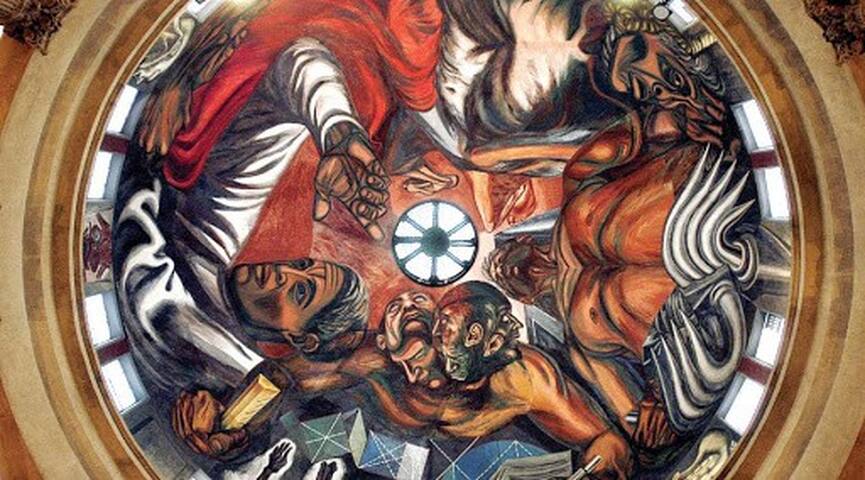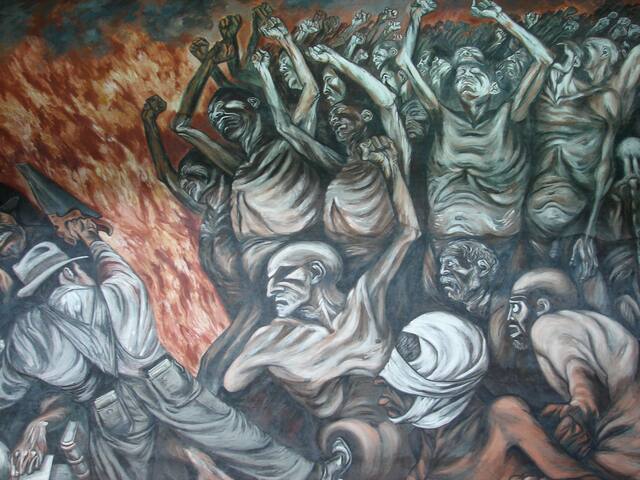Lugares emblemáticos
The creative and rebellious man José Clemente Orozco 1935/1937.
. Orozco, who like the other muralists closely followed those theoretical discussions, tried to develop a similar argument by means of which the worker was understood as a man who deploys his faculties in five phases: work, creation, suffering, rebellion and The philosophy. I don't know if anyone has studied the relationship between Ponce's essay and Orozco's mural, but I would dare to assure that both shared the same premises about the "new Prometheus" that managed socialist thought in the 1930s.// El hombre creador y rebelde.José Clemente Orozco1935/1937.
. Orozco, que como los demás muralistas seguía de cerca aquellas discusiones teóricas, intentó desarrollar un argumento similar por medio del cual el obrero era entendido como un hombre que despliega sus facultades en cinco fases: el trabajo, la creación, el sufrimiento, la rebelión y la filosofía. No sé si alguien ha estudiado la relación entre el ensayo de Ponce y el mural de Orozco, pero me atrevería a asegurar que ambos compartieron las mismas premisas sobre el "nuevo Prometeo" que manejó el pensamiento socialista en los años 30.
204 lokalinvånare rekommenderar
University of Guadalajara
976 Av JuárezThe creative and rebellious man José Clemente Orozco 1935/1937.
. Orozco, who like the other muralists closely followed those theoretical discussions, tried to develop a similar argument by means of which the worker was understood as a man who deploys his faculties in five phases: work, creation, suffering, rebellion and The philosophy. I don't know if anyone has studied the relationship between Ponce's essay and Orozco's mural, but I would dare to assure that both shared the same premises about the "new Prometheus" that managed socialist thought in the 1930s.// El hombre creador y rebelde.José Clemente Orozco1935/1937.
. Orozco, que como los demás muralistas seguía de cerca aquellas discusiones teóricas, intentó desarrollar un argumento similar por medio del cual el obrero era entendido como un hombre que despliega sus facultades en cinco fases: el trabajo, la creación, el sufrimiento, la rebelión y la filosofía. No sé si alguien ha estudiado la relación entre el ensayo de Ponce y el mural de Orozco, pero me atrevería a asegurar que ambos compartieron las mismas premisas sobre el "nuevo Prometeo" que manejó el pensamiento socialista en los años 30.
The people and their false leaders, José Clemente Orozco1935 / 1937.
The "mass" are skeletal, dumb and blind men who raise their arms in protest against the "leaders", dressed as workers (in overalls), grotesque in appearance, who in turn repel the attack of the angry people. It is made up of three panels: left, central and right. The fiery mass was already crying out its slogans from the blade that, for the first time, captured its shapes and silhouettes. In the wall, the increase in its dimensions also contributed to increase the echo of their protests. In the midst of the tumult, a reclining individual stands out, who will then appear blinded by a bandage.
The false leaders show from the outlines their indifference to the claims of the people. With the use of weapons and the argument of theories they try to preserve their power. //El pueblo y sus falsos líderes.José Clemente Orozco1935/1937.
La "masa" son hombres esqueléticos, mudos y ciegos que levantan sus brazos en señal de protesta contra los "líderes", vestidos como obreros (con overoles), de apariencia grotesca, que a su vez repelen el ataque del pueblo enardecido. Está compuesto por tres paneles: izquierdo, central y derecho. La masa enardecida clamaba ya sus consignas desde la hoja que, por primera vez, capturó sus formas y siluetas. En el muro, el aumento de sus dimensiones también contribuyó a incrementar el eco de sus protestas. En medio del tumulto sobresale un individuo recostado que, luego, se presentará cegado por una venda.
Los falsos líderes demuestran desde los bosquejos su indiferencia a los reclamos del pueblo. Con el uso de armas y el argumento de teorías pretenden conservar su poderío.
204 lokalinvånare rekommenderar
University of Guadalajara
976 Av JuárezThe people and their false leaders, José Clemente Orozco1935 / 1937.
The "mass" are skeletal, dumb and blind men who raise their arms in protest against the "leaders", dressed as workers (in overalls), grotesque in appearance, who in turn repel the attack of the angry people. It is made up of three panels: left, central and right. The fiery mass was already crying out its slogans from the blade that, for the first time, captured its shapes and silhouettes. In the wall, the increase in its dimensions also contributed to increase the echo of their protests. In the midst of the tumult, a reclining individual stands out, who will then appear blinded by a bandage.
The false leaders show from the outlines their indifference to the claims of the people. With the use of weapons and the argument of theories they try to preserve their power. //El pueblo y sus falsos líderes.José Clemente Orozco1935/1937.
La "masa" son hombres esqueléticos, mudos y ciegos que levantan sus brazos en señal de protesta contra los "líderes", vestidos como obreros (con overoles), de apariencia grotesca, que a su vez repelen el ataque del pueblo enardecido. Está compuesto por tres paneles: izquierdo, central y derecho. La masa enardecida clamaba ya sus consignas desde la hoja que, por primera vez, capturó sus formas y siluetas. En el muro, el aumento de sus dimensiones también contribuyó a incrementar el eco de sus protestas. En medio del tumulto sobresale un individuo recostado que, luego, se presentará cegado por una venda.
Los falsos líderes demuestran desde los bosquejos su indiferencia a los reclamos del pueblo. Con el uso de armas y el argumento de teorías pretenden conservar su poderío.
In 1937, he was invited to paint the interior of the main chapel. Less than two years it took him to carry out this impressive work, considered a World Heritage Site by Unesco along with the entire building, designed by Manuel Tolsá. There are 57 frescoes where you can see some scenes of the Conquest and the subsequent evangelization, the slavery of the indigenous people, the transformation of their world to a new society that contributed western writing and reading, expanding the understanding of Mexicans while the cheated, stole and murdered. He always viewed the ancient Mexican civilization with horror and admiration. In the center of the chapel is The Man on Fire, a piece that can be admired from any angle without the figures deforming. It shows four stages in the life of the human being: youth, maturity, old age and, at the center, a possible rebirth in the style of the Phoenix Bird. As the poet, essayist, and scholar of the plastic arts wrote Octavio Paz in his book The Privileges of Sight, “Orozco does not count or tell; Nor does he interpret: he confronts the facts, questions them, looks for a revelation that the seasoned visitor can discover. ” //En 1937, éste fue invitado a pintar el interior de la capilla mayor. Menos de dos años le tomó realizar esta imponente obra, considerada Patrimonio Mundial por la Unesco junto con todo el edificio, diseñado por Manuel Tolsá. Son 57 los frescos en donde se puede apreciar algunas escenas de la Conquista y la posterior evangelización, la esclavitud de los indígenas, la transformación de su mundo a una nueva sociedad que aportó la escritura y la lectura occidental ampliando la comprensión de los mexicanos mientras los engañaba, robaba y asesinaba. Siempre vio a la antigua civilización mexicana con horror y admiración. En el centro de la capilla se encuentra El hombre en llamas, pieza que se puede admirar desde cualquier ángulo sin que las figuras se deformen. Muestra cuatro etapas en la vida del ser humano: la juventud, la madurez, la vejez y, al centro, un posible renacimiento al mero estilo del Ave Fénix. Como escribió el poeta, ensayista y estudioso de las artes plásticas Octavio Paz en su libro Los privilegios de la vista, “Orozco no cuenta ni relata; tampoco interpreta: confronta los hechos, los interroga, busca en ellos una revelación que puede descubrir el visitante avezado”.
41 lokalinvånare rekommenderar
Cabañas kulturinstitut
8 C. CabañasIn 1937, he was invited to paint the interior of the main chapel. Less than two years it took him to carry out this impressive work, considered a World Heritage Site by Unesco along with the entire building, designed by Manuel Tolsá. There are 57 frescoes where you can see some scenes of the Conquest and the subsequent evangelization, the slavery of the indigenous people, the transformation of their world to a new society that contributed western writing and reading, expanding the understanding of Mexicans while the cheated, stole and murdered. He always viewed the ancient Mexican civilization with horror and admiration. In the center of the chapel is The Man on Fire, a piece that can be admired from any angle without the figures deforming. It shows four stages in the life of the human being: youth, maturity, old age and, at the center, a possible rebirth in the style of the Phoenix Bird. As the poet, essayist, and scholar of the plastic arts wrote Octavio Paz in his book The Privileges of Sight, “Orozco does not count or tell; Nor does he interpret: he confronts the facts, questions them, looks for a revelation that the seasoned visitor can discover. ” //En 1937, éste fue invitado a pintar el interior de la capilla mayor. Menos de dos años le tomó realizar esta imponente obra, considerada Patrimonio Mundial por la Unesco junto con todo el edificio, diseñado por Manuel Tolsá. Son 57 los frescos en donde se puede apreciar algunas escenas de la Conquista y la posterior evangelización, la esclavitud de los indígenas, la transformación de su mundo a una nueva sociedad que aportó la escritura y la lectura occidental ampliando la comprensión de los mexicanos mientras los engañaba, robaba y asesinaba. Siempre vio a la antigua civilización mexicana con horror y admiración. En el centro de la capilla se encuentra El hombre en llamas, pieza que se puede admirar desde cualquier ángulo sin que las figuras se deformen. Muestra cuatro etapas en la vida del ser humano: la juventud, la madurez, la vejez y, al centro, un posible renacimiento al mero estilo del Ave Fénix. Como escribió el poeta, ensayista y estudioso de las artes plásticas Octavio Paz en su libro Los privilegios de la vista, “Orozco no cuenta ni relata; tampoco interpreta: confronta los hechos, los interroga, busca en ellos una revelación que puede descubrir el visitante avezado”.


